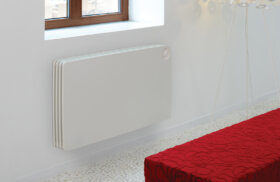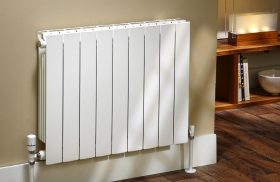We love it when people come into our showrooms to ask questions about radiators, and we actively encourage them to do so. After all, if you are fully informed, you will always make the best decisions.
We’ve noticed that there are some questions we get asked more often than others, so we thought it’d be a good idea to put the answers to the most commonly asked ones in a blog.
1. What size radiator do I need to heat my room?
Obviously, this is going to depend mainly on the size of your room. But have you thought about the other factors that will affect how much heat output you will need from a radiator?
Whether the room is on the ground or first floor, or in the attic or basement, will affect how efficiently a radiator will heat it, as will the number of windows and outside walls, and the height of the ceiling.
We always say it’s best to double-check with us before you buy your radiators to confirm you’re ordering the right ones. However, to give you a rule of thumb idea of the size of radiator you’ll probably need – which will help with your budget calculations – try our online heat output calculator (Important things to note about the heat output calculator)
2. Are designer radiators compatible with all central heating systems and combi-boilers?
The short answer is yes. All our designer radiators are compatible with British standard systems, combi-boilers and fittings, so you don’t need to worry about the practicalities of installation when you’re choosing your favourite design.
3. Do radiators have to be placed underneath the window?
No, they don’t. The accepted wisdom is that the best part of the room to place your radiator is in the coldest part, which is why they’re so often put underneath windows.
However, modern designer radiators are extremely efficient which means they can be placed anywhere you want them and will still heat the entire room. So if you’re choosing a radiator as a piece of art, you can place it where it’ll get the most attention.
4. What’s the best radiator for my conservatory?
There are several different ways of heating your conservatory. Trench heating (What is Trench Heating?) is really effective as it produces a ‘curtain’ of warm air, making it ideal for large glazed areas and doorways.
Alternatively, use floor standing radiators to heat areas around the glass. If it would be too expensive to connect your conservatory to your central heating system, try a designer electric radiator.
5. Is it possible to have an eco-friendly radiator?
Modern radiators are becoming more energy efficient and, in conjunction with good insulation, can reduce the amount of energy you use. Aluminium radiators could save up to 10% on energy costs due to the lower water content that needs to be heated.
In addition, aluminium is a fantastically recyclable material, making it easy to dispose of at the end of its life. Indeed, it is likely that your aluminium radiator will have started life as something else before it was recycled into its current form.
Finally, there is a new eco-kid on the block in the form of Livingstone radiators. They are made from the powder produced by marble cutting, which is then moulded and left to dry naturally, meaning far fewer emissions are involved in the manufacturing process.
The radiators are fully recyclable, so at the end of their lifespan, they can be broken down and regenerated as another beautiful radiator!





